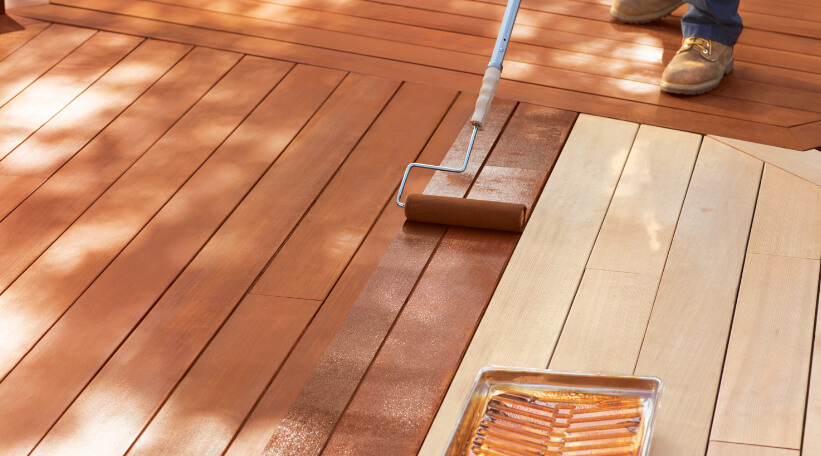Decks need more coatings protection that just about any other home surface.
By Tammy Adamson-McMullen
There are few home surfaces that get more wear and tear than decks. They not only get more than their fair share of foot traffic, especially at this time of year, but also can be damaged by dragging chairs, spillage from barbecues, leaking flowerpots, bird droppings and all sorts of other “culprits.” Decks also are exposed to all that Mother Nature has to offer and can be damaged by heat, cold, humidity, sun, rain, wind, snow and/or ice.
Consequently, it’s imperative that you purchase a quality stain to keep your deck protected. Should you stain a deck rather than painting it? You certainly can paint it, but stains are designed to penetrate the wood surface and therefore offer additional, long-lasting protection.
Here, then, are some tips for choosing the right one.
Think “Protection”
It’s true that quality stains generally cost more than lesser-quality stains. However, because of their improved ingredients, quality stains also will do a better job of reviving, penetrating and protecting your deck surface. Your deck not only will look better, but the look also will last longer so that you won’t have to recoat it as often.
Pigments, resins and additives are the three ingredients that spell the difference between a quality and lesser-quality stain. Quality stains have superior pigments, which provide rich, durable color; improved resins, which tightly bind the coating to the surface, and a range of additives, such as mildewcides and water repellants. So, the lesson here is to purchase the best stain you can afford. For guidance, talk to your local paint and decorating retailer to see which products have the best ingredients and work within your budget.
Oil- or Water-Based?
You’ll also need to decide if you want to purchase an oil- or water-based stain. In general, oil-based stains do a better job of penetrating wood surfaces and offer long-lasting protection. However, cleanup is more difficult with an oil-based product and may require solvents to do the job thoroughly.
Water-based stains have come a long way in their ability to protect wood surfaces, plus they dry quickly and are easy to clean up. But they don’t penetrate as deeply as oil-based or last quite as long. This is another topic you might want to discuss with your paint and decorating retailer. Be sure to describe all of the aspects of the project and the results you hope to achieve.
Type of Stains
There are many types of stains on the market; however, it’s important not to confuse sealers with stains. Sealers are clear coatings that either penetrate the wood or form a clear coating on top. They’re designed to protect against water damage but lack pigments that protect against UV damage, which can make the wood appear silvery over time. Still, some homeowners prefer the look of natural wood, which a sealer can provide. Sealers are easy to apply but need to be reapplied on a yearly basis.
In the stain category, there are several types to choose from, listed below in ascending order of pigmentation.
- Toners: These coatings typically just have a bit of color and allow the full wood grain to show through the coating. Like sealers, toners need to be reapplied frequently.
- Semi-transparent: These stains offer a bit more color but still allow the grain to show through the coating. They last between two to three years.
- Semi-solid: Also called semi-opaque, these stains offer rich color—and therefore great UV protection—and hide all but a hint of the wood grain. Semi-solid stains only need to be applied every three to four years.
- Solid or Opaque: These stains have dense, rich pigments and offer the best UV protection. Choose this stain if you don’t mind the wood grain being entirely covered. This stain lasts between three to five years.
Additional Considerations
Even the best quality stain won’t perform properly without good surface preparation. Before you stain, make sure your deck is free of dirt, grime, mold and mildew and debris. Sweep the deck thoroughly and use a deck cleaner, following the directions on the container. Clean the deck and all of the rail components, too. Allow the deck to dry thoroughly. Sand rough areas and any leftover residue before applying the stain.
When applying the stain, also make sure you use top-quality sundries that are intended for this purpose. Don’t cut corners here, or your deck may not have the appearance you want to achieve. (Check with your local paint and decorating retailer for guidance.)
Once the stain has cured, you can move your outdoor furniture, barbecue, flowerpots and other accoutrements onto the surface. Now comes the best part—enjoying the great outdoors and all of the compliments on a job well done!

 Interior Paints
Interior Paints Exterior Paints
Exterior Paints Primers
Primers Stains & Clears
Stains & Clears
 Paint Brushes
Paint Brushes Paint Roller
Paint Roller Paint Trays & Liners
Paint Trays & Liners



